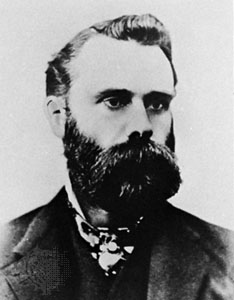 There are very few writings on technical analysis that have stood the test of time and truly deserve respect but the Dow Theory is unquestionably one of them.
There are very few writings on technical analysis that have stood the test of time and truly deserve respect but the Dow Theory is unquestionably one of them.
Charles Dow was one of the true Pioneers of Technical Analysis; he even created the first stock index; The Dow Jones Industrial Average. In 1899 he published a series of editorials in the ‘Wall St Journal’ (which he also founded). These editorials became the basis of his now famous Dow Theory. Although many people today use his theory as the basis for market timing it was originally intended as a way to measure general business trends.
.
The Dow Theory consists of 6 parts
.
- The Market Discounts Everything
.
The market represents the most democratic indication of stock value. The price of a stock in a free, competitive market reflects all that is known, believed, surmised, hoped, or feared and therefore it combines the attitudes and opinions of all.. - The Market Has Three Trends
..
- The Primary Trend can be either Bullish or Bearish and tends to last from 1 to several years. Manipulation of the primary trend is not possible.
. - Secondary Trends are short corrections to the Primary Trend. They tend to last 1 – 3 months and retrace 1/3 – 2/3 of the last movement of the Primary Trend.
. - Minor Trends can last from a day to several weeks. At this time frame the market is subject to manipulation and can be misleading.
.
.
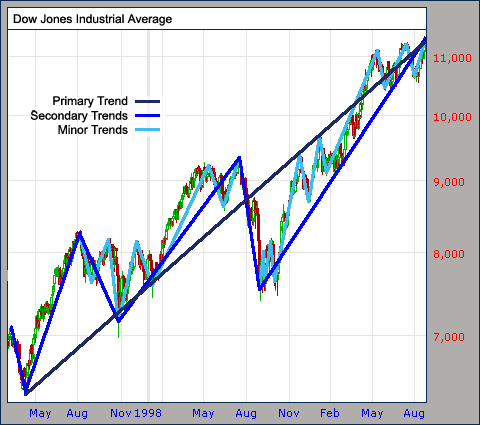
.
- The Primary Trend can be either Bullish or Bearish and tends to last from 1 to several years. Manipulation of the primary trend is not possible.
- Primary Trends Have Three Phases
.- Phase A is started by the Value Investors and the ‘Smart Money’ who begin to aggressively acquire stocks because their fundamental analysis indicates that the market is trading at a deep discount. This buying absorbs any excess supply and the bottom of the market is established. Even if the economy is still in bad shape, it is not as bad as stock prices would suggest so in the foreseeable future higher prices are inevitable..
.
- Phase B – The sentiment during this period is of extreme pessimism – “The sky is falling and we are all doomed”. The Smart Money is like a kid in a candy store picking up exceptional companies at bargain prices (often below their intrinsic value). Slowly earnings increase and good news becomes the norm. The General Public is very cautious but begins to accumulate stock under the improving conditions.
. - Phase C – Is recognized by record earnings and perfect economic conditions. The general public (with a short memory for how they lost it all last time) starts taking investment advice from their Taxi Driver who just made killing off the latest IPO. Everyone (the general public) is certain that the market is headed for the Moon. This escalates into a buying frenzy; pushing prices to dizzying heights. Such lofty valuations cause the Smart Money to begin moving their money into safer areas in anticipation of the inevitable correction.
.
“Be fearful when others are greedy and to be greedy only when others are fearful.” – Warren Buffett
.
.
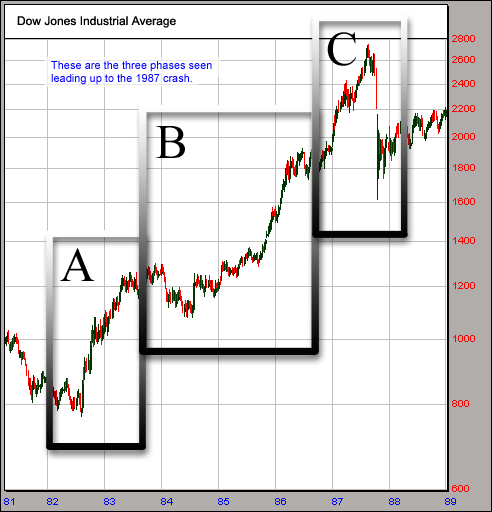
.
- Phase A is started by the Value Investors and the ‘Smart Money’ who begin to aggressively acquire stocks because their fundamental analysis indicates that the market is trading at a deep discount. This buying absorbs any excess supply and the bottom of the market is established. Even if the economy is still in bad shape, it is not as bad as stock prices would suggest so in the foreseeable future higher prices are inevitable..
- The Averages Must Confirm Each Other
.
Dow utilized two averages in his analysis; The Industrial Average and The Railroad Average (Now the Dow Transportation Index).In 1900 America was deep into the second Industrial Revolution which ran from about 1870 to 1914. During that time Railroads were of supreme importance to the increase of trade throughout the US. James Watt had recently improved the steam engine making it a viable piece of machinery.Steam locomotives allowed for quicker transportation of raw materials that could be used to produce finished goods and the transcontinental railroad was completed in 1869. The US suddenly had a quick passage from east to west. A journey that used to be a 4 – 6 month trek could now be accomplished by train in just six days!
According to Dow’s Theory, a bull market in Industrials could not occur unless the Railroad Average rallied as well. This logic is very sound; railroad companies can only prosper when the economy is flourishing and increasing quantities of goods are being transported. If the Railroad stocks are struggling then manufactures must be producing less. This made Railroad stocks extremely economically sensitive.
Dow created the Industrial Average to be like a measure of the tide on one part of the beach, and the Railroad Average was a measure on another part. Used in conjunction they helped to determine that the tide was indeed coming in or going out all along the seashore, rather that being tricked by rogue waves on one part of the beach.
Dow observed that both averages must make higher highs to confirm a bull market and vice versa. When the performance of the two averages diverged he saw it as an indication that there was a change in the tide.
.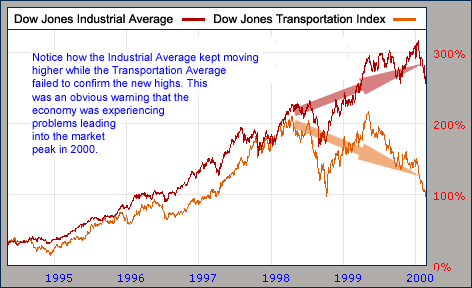 .
. - Volume Confirms The Trend.
.
Dow noted that volume should expand in the direction of the trend. Stronger volume should be seen on the days that the market is up in a bull market and down in a bear market.
.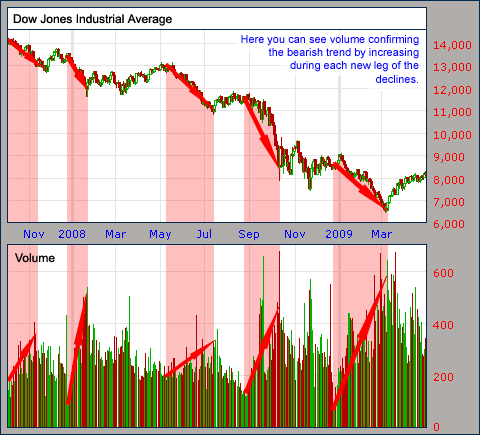
. - The Trend Remains Intact Until A Confirmed Reversal
.
A bullish trend can be described as consecutive higher highs and higher lows. To change to a bearish trend it is necessary to have at least one lower high and a lower low. This trend change must then be confirmed by the Transportation Index to have the greatest chance of continuing.
.
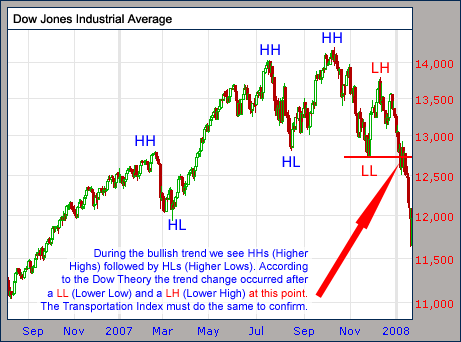
.
A Dow Theory For The Information Age
.
This is a theory written over 100 years ago before anyone had even heard of technical analysis, during a time before computers and charting software. It makes my head spin to think that Dow would have had to do all his charting by hand and if he was lucky he may have had the help of crude calculator the size of a suitcase. Yet it is amazing how timeless the principles he wrote about were and how valid they remain today. An understanding of these simple concepts is an invaluable foundation to effective technical analysis.
Apart from the way that Dow confirmed a trend reversal I agree with every aspect of his theory but the major difference today is that we have moved out of the Industrial Age and into the Information Age.
The invention of the micro processor making PCs affordable for the masses can be likened to James Watts improved steam engine making mass rail transportation a viable option. The way that the Internet opened up the global economy can be likened to how the transcontinental railroad in 1869 opened up ease of trade between the east and west of the US.
The Information Age has created a smaller, more integrated world where we already have the ability to work as a unit in real time. Communication, trade, employment, personal and commercial transactions are now occurring on a global scale. Largely, international and regional boundaries are being ignored; capital now flows far more freely between countries.
Profits in the Industrial Age came from economies of scale; factories and assembly lines. Now profits come from speed of innovation and the ability to attract and keep customers. In the new economy information is often the currency and the product.
In 1901 the biggest company in the world was U.S Steel with a market cap of approximately 35 billion in today’s dollars. Now, we have companies like Google that provide an electronic information service with no physical product. In November 2010 Google had a market cap of over 200 billion, six times that of U.S Steel in 1901.
Technology is at the forefront of the business cycle and semiconductors are at the forefront of technological advancement. All expansion requires semiconductors and any slowdown causes an expensive build up in inventory. Inventory that has a very short shelf life causing the Semis to feel the burn as soon as the business cycle begins to slow (a huge build up of inventory was seen leading up to the Tec bubble in 2000).
Semiconductors are the Railroads of the Information Age and are extremely economically sensitive. For this reason they play an integral part in identifying the markets true direction and why I use them along with the Transportation Index in a process I call ‘Holistic Market Analysis’. This is the process that I go through in the weekly ETF HQ Report (Subscribe Here For Free).
Essentially the Dow Theory looks for confirmation of the broad market trend from an economically sensitive industry at the front of the business cycle. Both Transportation and Semiconductors fit that criteria for now but perhaps in the future new Industries will evolve and take the lead.
Are you a believer in the Dow Theory? Have you had success or otherwise using it? What are some other industries that lead the business cycle? Share your thoughts in the comments section below.
The Dow Theory
There are very few writings on technical analysis that have stood the test of time and truly deserve respect but the Dow Theory is unquestionably one of them.
Charles Dow was one of the true Pioneers of Technical Analysis; he even created the Dow Jones Industrial Average, the worlds first Stock Index. In 1899 he wrote a series of editorials that that became the basis of his now famous Dow Theory in a paper he founded, called ‘The Wall Street Journal’. The articles were written with the intention of sharing a theory for measuring general business trends not for use as a market timing system.
The Dow Theory consists of 6 parts:
1. The market discounts everything
• The market represents the most democratic indication of stock value. The action of a stock in a free, competitive market reflects all that is known, believed, surmised, hoped, or feared and therefore it combines the attitudes and opinions of all.
2. The Market has three trends
• The Primary Trend can be either Bullish or Bearish and tends to last from 1 to several years. Manipulation of the primary trend is not possible.
• Secondary trends are short corrections to the Primary Trend. They tend to last 1 – 3 months and retrace 1/3 – 2/3 of the last movement of the Primary Trend.
• Minor Trends can last from a day to several weeks. At this time frame the market is subject to manipulation and can be misleading.
3. Primary Trends have three Phases
A. Phase – is started by the Value Investors. The ‘Smart Money’ begins to aggressively acquire stocks due to their fundamental analysis telling them that the market is trading at a deep discount. This buying absorbs any excess supply and the bottom of the market is established. Even if the economy is bad, it is not as bad as stock prices would suggest and in time the only possible direction is up.
Be fearful when others are greedy and to be greedy only when others are fearful.
– Warren Buffett
B. Phase – The sentiment during this period is of extreme pessimism – “The sky is falling and we are all doomed”. The Smart Money is like a kid in a candy store picking up exceptional companies at bargain prices, often below their intrinsic value. Slowly earnings increase and good news becomes the norm. The General Public is very cautious but begins to accumulate stock under the improving conditions.
C. Phase C can be recognised by record earnings and perfect economic conditions. The general public (with a short memory about how they lost it all last time) starts taking investment advice from their Taxi Driver who just made killing off the latest IPO. Everyone (the general public) is absolutely certain that the market is headed for the Moon.
This escalates into a buying frenzy and dizzying valuations. This alerts the Smart Money to begin moving their money to safer areas in anticipation of the inevitable bursting of the bubble.
Above is a Chart of the Dow Jones Industrial average leading up to the 87 crash with each of the three phases identified.
4. The Averages Must Confirm each other
• Charles Dow utilised two averages in his analysis; The Industrial Average and The Railroad Average (Now the Dow Transportation Index).
In 1900 America was deep into the second Industrial Revolution which ran from about 1870 to 1914. During this time railroads were of supreme importance to the increase of trade throughout the US. James Watt improved on the steam engine making it a viable piece of machinery in the second half of the 18th century. This development helped start the Industrial Revolution.
Steam locomotives allowed for quicker transportation of raw materials that could be used to produce finished goods. The transcontinental railroad was completed in 1869 and the US suddenly had a quick passage from east to west. A journey that used to be a 4 – 6 month trek could now be accomplished in just six days!
According to Dow’s Theory, a bull market in industrials could not occur unless the railway average rallied as well. This logic is very sound; railroad companies can only prosper when the economy is flourishing and increasing quantities of goods are being transported. If the rail road stocks are struggling then manufactures must be producing less. This made rail road stocks extremely economically sensitive.
Dow created the Industrial Average to be like a measure of the tide on one part of the beach, and the Railroad Average was a measure on another part. Used in conjunction they helped to determine that the tide was indeed coming in or going out all along the seashore, rather that being tricked by rogue waves on one part of the beach.
Both averages must make higher highs to confirm a bull market and vice versa. When the performance of the two averages diverge it is an indication of a change in the tide.
5. Volume Confirms the Trend
• Dow noted that volume should expand in the direction of the trend. Stronger volume should be seen on the days that the market is up in a bull market and down in a bear market.
6. The trend remains intact until a confirmed reversal
• A bullish trend can be described as consecutive higher highs and higher lows. To change to a bearish trend it is necessary to have at least one lower high and a lower low. This trend change must then be confirmed by the Railroad Average to have the greatest chance of continuing.
The Dow Theory and how it relates to us today
For a theory written over 100 years ago about technical analysis it is amazing how timeless the principles are and how valid they remain. An understanding of these few principles is an invaluable foundation to effective technical analysis. The major difference today is that we have moved out of the industrial age into the information age.
The invention of the micro processor making PCs affordable for the masses can be likened to James Watts improved steam engine making mass rail transportation a viable option. The way that the Internet opened up the global economy can be likened to how the transcontinental railroad in 1869 opened up ease of trade between the east and west of the US.
The Information Age has created a smaller, more integrated world, we already have the ability to work as a unit in real time. Communication, trade, employment, personal and commercial transactions are now occurring on a global scale. Largely, international and regional boundaries are being ignored; capital now flows far more freely between countries.
Profits in the industrial age came from economies of scale; factories and assembly lines. Now profits come from speed of innovation and the ability to attract and keep customers. In the new economy information is often the currency and the product.
In 1901 the biggest company in the world was U.S Steel with a market cap of approximately 35 billion in today’s dollars. Now, we have companies like Google that provides an electronic information service with no physical product. In November 2007 Google had a market cap of over 220 billion.
Technology is at the forefront of the business cycle and semiconductors are at the forefront of technological advancement. All expansion requires semiconductors and any slowdown causes an expensive build up in inventory. Inventory that has a very short shelf life causing the semis to feel the burn as soon as the business cycle begins to slow (a huge build up of inventory was seen in 2000).
Semiconductors are the rail roads of the information age and are extremely economically sensitive. That is why they play such an important part in identifying the markets true direction through a process I call ‘Holistic Market Analysis’. This is the process used in the weekly ETF HQ Report.